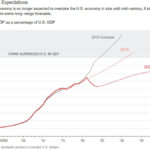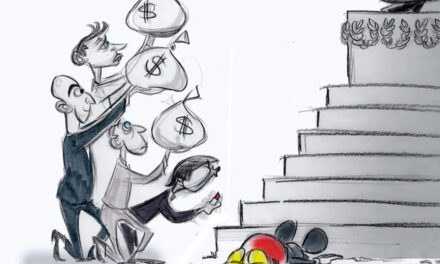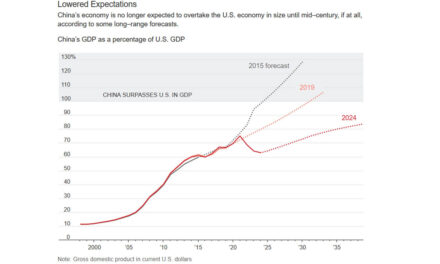
Global Supply Shortages Spark Inflation Fears

As American society is working towards reestablishing its sense of normality from the Covid 19 pandemic, citizens are seeing price jumps on everyday materials across the landscape of global production from cars and computers to lumber and food. When consumer demand continues to increase with record backlogs of supply, inflation risks intensify across the market. Semiconductors, steel, lumber, cotton, housing, computers, cars and certain foods are all amongst the industries experiencing the most production difficulty.
According to a JPMorgan Chase report, global manufacturing output prices are at the highest levels since the 2008 economic crash. The Bloomberg Commodity Spot Index tracking 23 focus raw materials reports the same that prices are the highest they have been on average for all items since 2008.
“The overall supply is constrained. That affects every part…” says Wingstop Chief Executive Charlie Morrison stated to the Wall Street Journal, claiming that they are paying up to 26% more for bone in chicken wings alone this year. Speaking with suppliers daily struggling to raise production, Morrison says that faults in the supply chain are due to businesses having trouble finding workers because of Covid 19 fears, stimulus and increased unemployment benefits.
Despite the shortage of workers and production, analysts at FactSet anticipate strong profits for chicken suppliers over the weeks leading up to the next quarterly report. The same is still occurring across other producer industries as well, with the stock market as a whole continuing to grow as many businesses report record earnings.
John Mothersole, research director at IHS Markit Analysis says, “ the surge in commodity prices over the past year now guarantees higher goods price inflation this summer”. With analysis on oil, chemicals, steel, copper, zinc, lumber, pulp and rubber, Mothersole still is optimistic and expects prices for all to fall by the year’s end.
The Federal Reserve agrees with this assessment, believing that all of our price increases are only temporary.
As millions of people are trying to get back to work and resume everyday life, The Consumer Price Index from the U.S. Bureau of Labor Statistics are now showing the largest month to month increases for consumer goods as a whole in nearly a decade, reporting in March alone consumer prices jumped an average of 2.6%.
V.V. Chari, an economics professor and advisor to the Federal Reserve Bank of Minneapolis states, “(The month to month data) is not something we should be unduly concerned about. We should be concerned about the possibility of persistent increases in inflation”.
With this still, as businesses cannot just wait for the prices to pass, the consumer will continue to pay for production increases.
Douglas Porter, chief economist at BMO Capital Markets, commented on May 1st that, “one always has to be careful not to overplay a few anecdotes and project that onto the broader economy, but as the anecdotes accumulate, they eventually become data… as rising inflation risks suggest, when you run things hot, you risk getting burned”.
The world economy isn’t magic. It takes workers to produce goods for us all to consume. All the money in the world will not matter if there is nothing to buy with it. Optimism is well good, but we cannot wait for this all to pass and hope that it is all good in the long run. No matter if inflation is another passing phase of the moment, a summer lull or if we see monthly increases for the long term future ahead, we must get back to working in the world of things to have true optimism about the economy moving forward and not to rest with statements from big money telling us workers not to worry about it and to just keep staying home.
We need to work or the economy won’t.

























Jacob, welcome to the platform. Great article!
It seems as if you are pointing to the stimulus as a major contributing factor of this inflation. That people don’t want to work in a chicken factory because they make more in unemployment.
I don’t think you are making the point you think you are.
Unemployment is roughly $1200 a month, or approximately $ 7 an hr, or about $12,000 a year. If employers can’t hire workers because they can’t compete with those numbers, it may be time they reconsider their business model.
TRUE!!!!!!!!
You either didn’t read it correctly or you conveniently left out the rest of Jacobs’s point to push your agenda. He not only cited unemployment which you correctly say the average is approximately $1200/month which averages out to approximately $7/hour, but he also cited the insidious federal unemployment kicker of $300/week and the “stimulus” (which varies with the number of dependents) When you add this in, it averages out to approximately $14-16/hour. Not a bad haul for those with no incentive to work.
Everyday you hear about those wanting a job but ask the potential employer to pay them under the table which, by the way, is illegal.
Everywhere you look there are help wanted signs, any business that is having trouble keeping inventory in stock will tell you it’s due to labor shortages (and many things are out of stock or back ordered with excessively long lead times).
It’s much easier for many to take the government cheese (path of least resistance) than it is to get up off their butt and pound the pavement for a job.
All this, along with the flood of illegal invaders, is being done by design to create a permanent dependent class that will always reliably vote Democrat.
Don’t ever think the Marxist regime that has been fraudulently installed does anything that isn’t political. They are beholden to the CCP and their globalist puppet masters.
Jack, you are not helping your cause. $15 is a livable wage. That’s why we have been pushing for it.
I know you don’t want to support a living wage, but think of it this way, when an employer pays poverty wages, we tax paying citizens help pad the businesses bottom line in the form of welfare subsidies. WIC, EBT, Section 8, Medicaid.. ect.
Let capitalism work for a change. Not this pseudo capitalism where companies reap the profits and socialism pays to lower companies expenditures.
In other words, YOUR taxes are paying for employees that work for poverty wages. Why not cut out the middleman ( you)
Unemployment from the federal government’s extra $300’s is $1200 a month. That $300 a week is on top of the unemployment that you would get from the state. Where I am from, max unemployment would be more like $2300 a month or closer to $14 an hour. Some states have an even higher max unemployment.
Anon,
In other words, a livable wage?
Chipotle Mexican Grill is hiking its average hourly pay to $15 as it vies for workers in an increasingly tight U.S. labor market.
The Mexican-themed food chain said Monday it would offer a starting wage of $11 to $18 an hour by the end of June. That’s a starting wage increase of approximately $2 an hour, the company stated